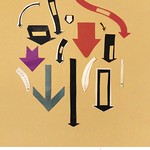Why We Fail

Learning from Experience Design Failures
Just as pilots and doctors improve by studying crash reports and postmortems, experience designers can improve by learning how customer experience failures cause products to fail in the marketplace. Rather than proselytizing a particular approach to design, Why We Fail holistically explores what teams actually built, why the products failed, and how we can learn from the past to avoid failure ourselves.
Just as pilots and doctors improve by studying crash reports and postmortems, experience designers can improve by learning how customer experience failures cause products to fail in the marketplace. Rather than proselytizing a particular approach to design, Why We Fail holistically explores what teams actually built, why the products failed, and how we can learn from the past to avoid failure ourselves.
Testimonials
The stories behind failures make for fascinating reading. But this book offers more. It provides important insights into both what can go right and what can go wrong in a product offering. To make great products, we need to understand what makes some fail and others succeed. To all the aspiring, young entrepreneurs who are reading this: take heed. Embrace failure to learn from failure. Learn from failure to avoid failure.
Don Norman Co-founder, Nielsen Norman Group Author of The Design of Everyday Things (Revised and Expanded)
Success feels great. But beyond the fleeting sensation of good will, what does it tell you? Failure, on the other hand, provides a gold mine of insights that can help you do better in the future—if you’re willing to do the hard work required to evaluate why things went wrong. Victor’s book provides a useful guide, with lots of examples that make it clear that you’re not alone in screwing up.
Karen McGrane, author of Content Strategy for Mobile
Success is boring. Failure is much more interesting—and instructive. In this practical and well-researched book, Victor Lombardi presents a series of vignettes about design projects gone wrong. He wisely avoids the temptations of schadenfreude, however, instead transforming these cautionary tales into useful lessons for the modern designer.
Alex Wright, Director of User Experience, The New York Times
At a time when companies are urged to fail early and often, Victor uses multiple case studies to take a sober look at what causes failure in product development, and provides useful tools to help teams avoid failure. His careful and thoughtful analysis should be required reading for every product team.
Neil Wehrle, Vice President of User Experience, betaworks
A diverse set of case studies to help illustrate experience design and its role in the development of 21st-century digital products and services. While intended to help companies avoid failure because of poor experience design, it’s also a good reminder that mistakes and errors, as long as shared openly, can be an important part of the development road to success. Victor’s proposed Experience Development method is a contemporary twist on the scientific method. His method may prove to be a useful framework for helping companies develop successful digital products and services, where success is measured by the subjective qualities of the intended users’ experience.
Leah Wang, Senior Vice President, Medscape/WebMD
By examining ambitious failures through the lens of experience design, you’re able to better understand why these teams made the decisions they did and, in doing so, arm yourself with the tools needed to avoid similar pitfalls
Alex Rainert, Head of Product, Foursquare
Exceptional user experiences are rare. Failures are common. You’ll be quickly reminded of that in Victor’s insightful analysis. But it’s the important lessons that we tend to forget. This book is full of thoroughly researched and insightful case studies on user experience failures in the digital realm. You’ll want to keep this book on your shelf to re-read again in the future when the industry comes back around to the brink of repeating some of the same failures. But maybe you’ll be in a position to tip success with what you’ve learned.
Mike Lee, Digital Strategist
Table of Contents
Chapter 1: Embrace Failure
Chapter 2: Get the Right Experience
Chapter 3: Get the Experience Right
Chapter 4: Platform Follows People
Chapter 5: Design for Reflection
Chapter 6: Generate Critical Mass
Chapter 7: Do the Right Thing
Chapter 8: Cannibalize Yourself
Chapter 9: Why We Fail
Chapter 10: Avoid Failure
FAQ
These common questions and their short answers are taken from Victor Lombardi’s book Why We Fail: Learning from Experience Design Failures . You can find longer answers to each in your copy of the book, either printed or digital version.
- What kinds of products are described in this book?
Of the ten products profiled in this book, four of them are websites (Classmates.com, Wave, Pownce, and Wesabe), two of them are services (Plaxo and OpenID), one is a software package (Final Cut Pro X), one is an operating system (Symbian), and two are hardware-based (iDrive and Zune). They were all generally created in the United States and Europe. All of them were designed for consumers rather than for businesses.













